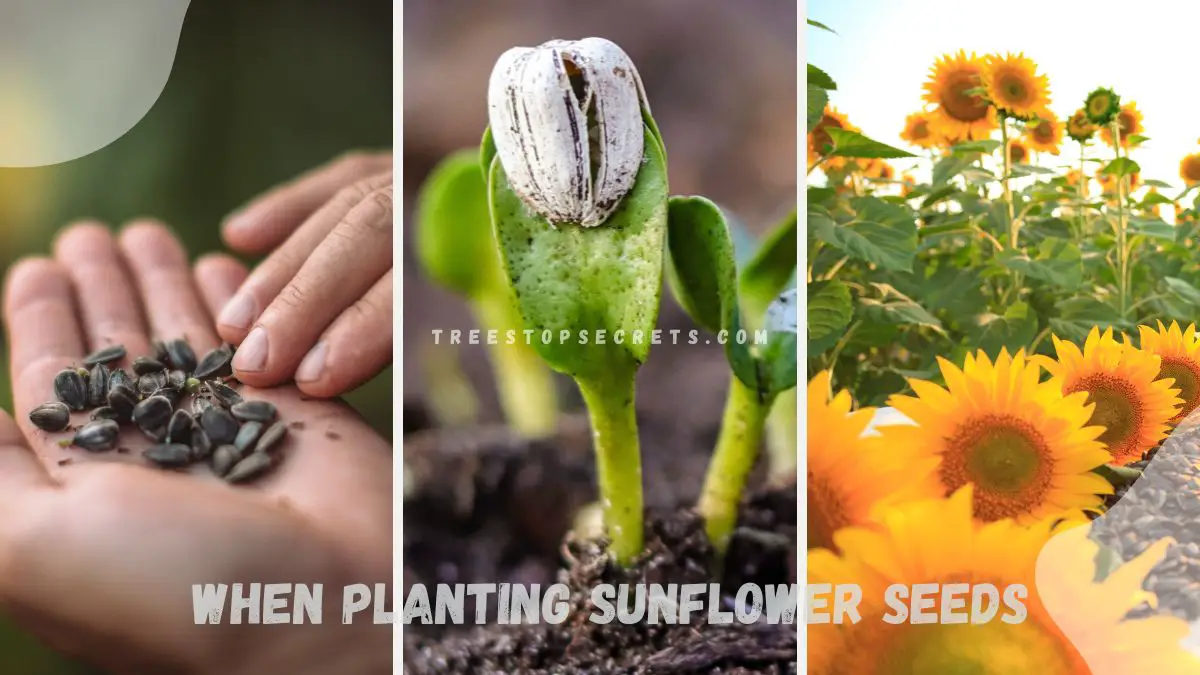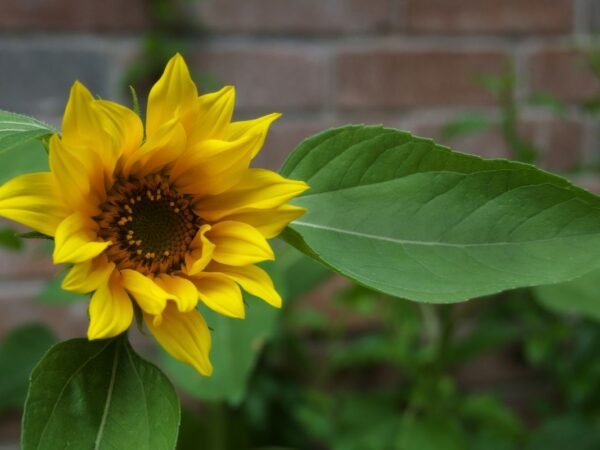When planting sunflower seeds, you'll find it's a straightforward and rewarding endeavor that even beginners can handle. These vibrant blooms are not only visually appealing but also attract pollinators, making them a great addition to any garden. Whether you’re aiming for ornamental beauty or a bountiful harvest of seeds, with the right soil, sunlight, and care, sunflowers can thrive in a variety of environments. With some basic guidance, you'll be well on your way to growing these impressive flowers successfully.
When planting sunflower seeds, start by choosing a sunny spot with well-draining soil. Plant seeds 1 to 1.5 inches deep and space them about 6 to 12 inches apart, depending on the variety. Sunflowers require full sunlight, so ensure they receive at least 6-8 hours of direct sun each day. Water them thoroughly after planting and maintain consistent moisture until germination, which typically occurs in 7-10 days. For optimal growth, thin seedlings to the recommended spacing once they reach 6 inches in height. Here's a quick planting guide:
| Step | Detail |
|---|---|
| Planting Depth | 1 to 1.5 inches |
| Seed Spacing | 6 to 12 inches |
| Sunlight Requirement | 6-8 hours per day |
| Germination Time | 7-10 days |
| Thinning | When seedlings reach 6 inches, space appropriately |
To ensure your sunflowers reach their full potential, we have detailed tips on watering, fertilizing, and dealing with pests. Explore our complete guide for a thriving sunflower garden.
Key Takeaways
- Understand the needs of sunflowers before planting to ensure proper care and growth.
- Prepare the soil adequately by loosening it and adding compost or fertilizer to provide a favorable environment for sunflower seeds.
- Plant sunflower seeds at the right time, typically in late spring after the last frost date, for optimal growth.
- Utilize proper planting techniques such as spacing seeds correctly and planting them at the appropriate depth.
- Care for sunflowers by watering them regularly, providing adequate sunlight, and protecting them from pests and diseases.
- Experiment with different propagation methods like seed starting indoors or direct sowing outdoors to find the best approach for your sunflowers.
Understanding Sunflowers
Sunflowers come in different varieties such as dwarf, branching, and giant types. Each type has unique characteristics like varying flower sizes and colors. Consider factors like space availability and desired height when choosing a sunflower type.
When planting sunflower seeds, ensure they receive 6-8 hours of direct sunlight daily for optimal growth. Use well-draining soil with good fertility to support healthy development. Remember to water consistently to keep the soil moist but not waterlogged.
Types to Grow
- Choose from dwarf, branching, or giant sunflower varieties.
- Consider factors like space availability and desired height.
- Different types offer unique characteristics such as flower size, color variations, and sunflower.
Ideal Conditions
- Ensure sunflowers receive at least 6-8 hours of direct sunlight daily.
- Provide well-draining soil with good fertility for optimal growth.
- Maintain a consistent watering schedule to keep the soil moist but not waterlogged.
Growth Stages
Sunflowers progress through seedling, vegetative, flowering, and seed development stages. Each stage requires specific care for healthy plant development. Understanding these stages helps anticipate the plant's needs at different times.
Preparing for Planting
Choosing Seeds
When selecting sunflower seeds, opt for high-quality ones from trusted sources to ensure better germination. Consider factors like bloom color, size, and growth habits to suit your preferences. Check seed packets for planting depth and spacing guidelines.
Soil Preparation
Begin by removing weeds and incorporating organic matter such as compost or manure into the soil. Ensure the soil is loose and well-aerated to encourage healthy root growth. Test the soil pH and adjust it if needed for optimal growing conditions.
Selecting a Location
For planting sunflowers, pick a sunny spot sheltered from strong winds to promote growth. Factor in the mature height of the sunflowers when choosing a location. Avoid areas near tall structures that could cast shade on the sunflowers during the day.
Timing for Planting
Best Months
The ideal time to plant sunflower seeds is between April and May for most regions. Consider local climate conditions and frost dates when determining the best planting months. Planting during the recommended months enhances seed germination and overall plant growth.
- Planting in April or May promotes optimal growth.
- Local climate and frost dates impact planting decisions.
- Enhances seed germination and overall plant health.
Indoor Start
Start sunflower seeds indoors in small pots filled with peat-free, multi-purpose compost. Provide warmth and moisture by covering the pots with a clear plastic bag until germination. Transplant seedlings outdoors after hardening them off gradually for a few weeks.
- Begin indoors using peat-free compost-filled pots.
- Cover pots with plastic for warmth and moisture.
- Gradually harden off seedlings before outdoor transplant.
Outdoor Timing
Wait to plant sunflower seedlings outdoors until the soil has warmed considerably. Consider the risk of frost and ensure outdoor temperatures are suitable for plant growth. Planting at the right time improves the chances of successful establishment in the garden.
- Delay outdoor planting until soil warms up.
- Check for frost risks before outdoor planting.
- Optimal timing boosts successful garden establishment.
Planting Techniques
Outdoor Planting
When planting sunflower seeds outdoors, ensure they are at the same depth as in the pot to prevent stem rot. Water the seedlings thoroughly after planting to aid in their establishment. Stake taller varieties to offer support against strong winds and heavy rain.
Indoor Germination
Indoor germination of sunflower seeds involves monitoring for signs of germination like seedling emergence. Adjust the watering frequency to maintain consistently moist soil without waterlogging it. Remove the plastic cover once the seedlings have sprouted to prevent mold growth.
Transplanting Seedlings
When transplanting sunflower seedlings, handle them carefully to prevent root damage. Ensure the outdoor planting site receives adequate sunlight and has well-draining soil. Water the transplanted seedlings immediately post-planting to reduce transplant shock.
Caring for Sunflowers
Watering Needs
Sunflowers require regular watering, especially in hot weather. Deeply water to encourage strong roots and drought resistance. Monitor soil moisture for proper hydration.
Sunlight Requirements
Provide sunflowers with full sun exposure for healthy growth and abundant blooms. Ensure no shading structures block sunlight. Adjust plant positioning for maximum sunlight exposure.
Soil Maintenance
Maintain soil fertility with organic matter like compost or aged manure annually. Mulch around plants to retain moisture and suppress weeds. Check soil pH and nutrient levels for optimal growth conditions.
Propagation Methods
Seed Harvesting
Harvest sunflower seeds when the flower heads are dry and brown. Hang them to dry in a well-ventilated area. Remove and store seeds in a cool, dry place.
Propagating Tips
Propagate sunflowers by collecting seeds from mature flower heads. Save seeds from healthy plants for future planting. Properly label and store seeds for maintaining viability.
Troubleshooting Growth Issues
Common Problems
Sunflowers may face common issues such as powdery mildew, aphids, and root rot. These problems can hinder plant growth and overall health. To prevent these issues, ensure proper spacing between plants and promote good air circulation around them. By maintaining a healthy environment, you can reduce the risk of infestations and diseases.
To tackle these problems, it's essential to identify them early on. Powdery mildew appears as a white powdery substance on leaves, while aphids cluster on plant stems and leaves, sucking sap. Root rot causes wilting and yellowing of leaves due to fungal infection. By recognizing these signs promptly, you can take action to address them effectively.
Implement preventive measures by incorporating organic solutions. Utilize neem oil or insecticidal soap to control pests like aphids. Prune affected plant parts carefully and dispose of them properly to prevent the spread of diseases. Regularly monitor your sunflowers for any signs of distress and act promptly to minimize damage and ensure healthy growth.
- Proper spacing and air circulation
- Early identification of issues
- Organic pest control methods
Solutions Guide
When facing pest infestations, resort to natural remedies like neem oil or insecticidal soap. These solutions effectively combat common pests without harming the environment. Pruning affected parts of the plant is crucial in preventing the spread of diseases. Dispose of these parts properly to avoid further contamination.
Regularly monitoring your sunflowers is key to maintaining their health. By keeping a close eye on their growth and appearance, you can swiftly address any emerging issues before they escalate. Prompt action is vital in preserving the vitality of your plants and ensuring a successful growing season.
- Use neem oil or insecticidal soap
- Prune affected plant parts
- Regular monitoring for early intervention
Enjoying Your Sunflowers
Harvesting Seeds
Harvest sunflower seeds when the back of the flower heads turns yellow and the seeds appear plump. Dry the harvested seeds thoroughly before storing them in airtight containers. Label the containers with the harvest date and seed variety for easy identification.
Decorative Uses
Use sunflowers as vibrant additions to floral arrangements and bouquets. Create decorative wreaths or centerpieces using dried sunflower heads. Incorporate sunflowers into seasonal decorations for a cheerful and natural touch.
Final Remarks
You now possess a comprehensive guide on planting and caring for sunflowers. Understanding the growth process, preparation, timing, planting techniques, care tips, propagation methods, and troubleshooting strategies equips you to nurture vibrant sunflowers successfully. By following these steps diligently, you ensure your sunflowers thrive and bloom beautifully. Remember to enjoy the process and celebrate the results of your efforts.
Incorporate these insights into your gardening routine and relish the sight of stunning sunflowers gracing your garden. Share your newfound knowledge with fellow gardening enthusiasts to spread the joy of cultivating these magnificent flowers. Embrace the journey of growing sunflowers and witness the beauty they bring to your outdoor space.
Frequently Asked Questions
When is the best time to plant sunflower seeds?
The best time to plant sunflower seeds is in late spring after the last frost date has passed. This timing allows the soil to warm up, providing optimal conditions for seed germination and sunflower growth.
How should I prepare the soil for planting sunflower seeds?
Prepare well-draining soil by loosening it with a garden fork or tiller. Remove any debris and weeds from the planting area. Incorporate organic matter like compost to improve soil fertility and provide nutrients for healthy sunflower growth.
What are some recommended planting techniques for sunflower seeds?
Plant sunflower seeds 1-2 inches deep in the soil, spacing them 6-12 inches apart depending on the variety. Water the seeds immediately after planting to ensure good soil contact. Consider planting in rows or clusters to create a visually appealing display.
How do I care for sunflowers once they are planted?
Water sunflowers regularly, especially during dry periods, to keep the soil consistently moist but not waterlogged. Fertilize with a balanced fertilizer every few weeks to promote healthy growth. Monitor for pests and diseases, removing any affected parts promptly.
What are some common propagation methods for sunflowers?
Sunflowers can be propagated from seeds, cuttings, or division. Seeds are the most common method and are easy to collect from mature flower heads. Cuttings can be taken from healthy plants to produce new ones. Division involves separating root clumps to create multiple plants.
Image Source: Paid image from CANVA




